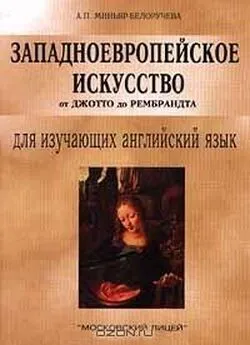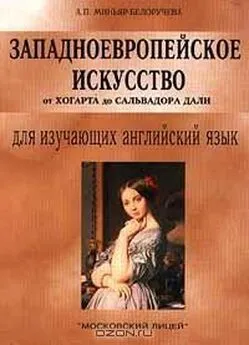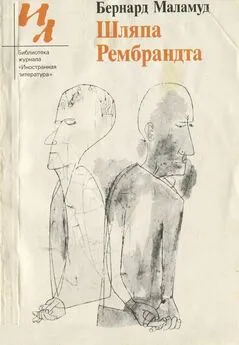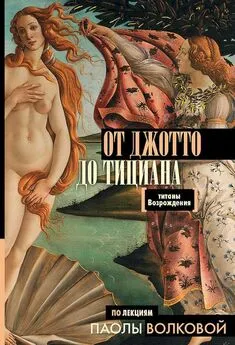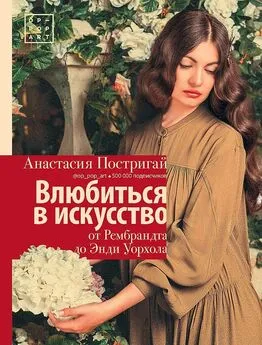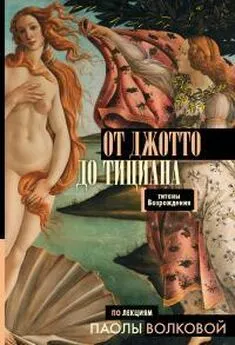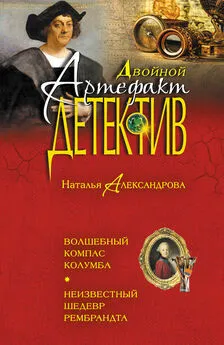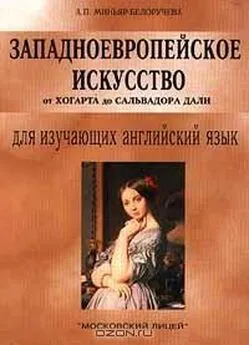А. Миньяр-Белоручева - Западноевропейское искусство от Джотто до Рембрандта
- Название:Западноевропейское искусство от Джотто до Рембрандта
- Автор:
- Жанр:
- Издательство:«Московский Лицей»
- Год:1999
- Город:Москва
- ISBN:5-7611-0181-5
- Рейтинг:
- Избранное:Добавить в избранное
-
Отзывы:
-
Ваша оценка:
А. Миньяр-Белоручева - Западноевропейское искусство от Джотто до Рембрандта краткое содержание
Тексты настоящего пособия охватывают пять веков западноевропейской живописи от Джотто до Рембрандта. Это дает возможность обучаемым приобрести не только лингвистические знания, усвоив обширный лексический материал, но и культурологические, поскольку последовательный хронологический переход текстов от одного художника к другому позволяет создать более или менее целостную картину развития западноевропейской искусства с XIII по XVII вв. Система упражнений направлена на усвоение лексического материала и развитие навыков устной речи.
Данная книга является первой частью цикла учебных пособий для изучающих английский язык и предназначена для студентов-искусствоведов, учащихся классических гимназий, лицеистов и всех интересующихся искусством.
Учебный центр «Московский Лицей»
пособие для изучающих английский язык
издание второе переработанное и дополненное
Москва -1999
Рецензенты:
И. И. Малинина кандидат филологических наук
Н. В. Васютина кандидат филологических наук
РЕКОМЕНДОВАНО кафедрой иностранных языков исторического факультета МГУ им. М. В. Ломоносова
Западноевропейское искусство от Джотто до Рембрандта - читать онлайн бесплатно полную версию (весь текст целиком)
Интервал:
Закладка:
The heroic style for which Michelangelo is generally known is seen in the David more than 14 feet in height, which was carved in 1501-4, for a lofty position on one of the buttresses of the Cathedral of Florence. When the statue was completed, it was so beautiful that the Florentines could not sacrifice it in such a position. It was placed in front of the Palazzo Vecchio, where it became a symbol of the republic ready for battle against its enemies. The David became the first true colossus of the High Renaissance.
In 1505 Michelangelo was called by the warrior pope Julius II to design a tomb for him. This project with more than forty over-life statues in marble and bronze relief would require a lifetime. After several successive reductions the tomb was brought to completion only in 1545. Three statues remain from the 1505 version.
The world-famous statue of Moses was intended for a corner position on the second story of the monument so that it could be seen from below. Like all of Michelangelo's works, the Moses , is symbolic and timeless. Moses is conceived as an activist prophet, a counterpart to Saint Paul. The bulk of the figure is almost crushing. Moses' head with its two-tailed beard, is one of the artist's most formidable creations; the locks of the beard are lightly drawn aside by the fingers of his right hand. The drapery masses enhance the compactness of the figure.
The two Slaves for the 1505 and 1513 versions of the tomb were planned to flank niches around the lower story, in which were to stand Victories. The figure called the Dying Slave is actually not dying but turning languidly as if in sleep; one hand is placed upon his head, the other pulls unconsciously at the narrow bond of cloth across his massive chest. The strikingly different companion figure, the Rebellious Slave , exerts all his gigantic strength in vain against the slender bond that ties his arms. The new figure type created by Michelangelo in the David , and set in action here for the first time, established a standard that influenced a great number of artists. Throughout the late Renaissance and the Baroque, Michelangelesque heavy muscled figure was almost universally imitated.
In 1508 Michelangelo was given a commission to fresco the ceiling of the Sistine Chapel. The upper walls had been frescoed in the 1480s by Botticelli, Ghirlandaio, Perugino and SignorellI. Julius II asked Michelangelo to paint the ceiling, a flattened barrel vault more than 130 feet long. It was the most ambitious undertaking of the entire Renaissance.
The painting represented the drama of the Creation and Fall of Man and consisted of nine scenes, beginning with the Separation of Light from Darkness and ending with the Drunkenness of Noah . In the vault compartments above the windows and in the lunettes around the windows are represented the forty generations of the ancestry of Christ, and in the spandrels at the corners of the Chapel are pictured David and Goliath, Judith and Holofernes , the Crucifixion of Human and the Brazen Serpent .
In this intricate iconographic structure the coming of Christ is foretold in the nine scenes from Genesis, according to the principle of correspondence between the Old and New Testaments that was illustrated repeatedly throughout Christian art. An added element is the oak tree of the Rovere family, to which Julius II and his uncle Sixtus iv belonged. The Rovere oak tree invaded the, scenes of Creation and alluded poetically to the Tree of Life, which stood near the Tree of Knowledge in the Garden of Eden and whose fruit in medieval theology was Christ.
The Fall of Man combines the Temptation and the Expulsion in a single scene, which in one motion leads the eye from the crime to punishment, linked by the Tree of Knowledge, represented as a fig tree. Never in history had nude figures been painted on such a colossal scale.
Michelangelo's vision of a new and grander humanity reaches its supreme embodiment in the Creation of Adam . Instead of standing on earth as in all earlier Creation scenes, the Lord floats through the heavens and is enveloped in the violet mantle he wears in all the scenes in which he appears. The violet colour is required for the vestments of the clergy during Advent and Lent, the penitential periods before the coming of Christ at Christmas and his resurrection at Easter. The Lord is borne by wingless angels. Michelangelo's Creator for the first time makes believable the concept of omnipotence. A dynamo of creative energy, God stretches forth his hand, about to touch with his finger the extended finger of Adam. This image of the creative finger derives from the famous medieval hymn «Come, Creator Spirit» sung at Pentecost, the festival of the Descent of the Holy Spirit. In this hymn the «finger of the paternal right hand» is invoked to bring speech to our lips, light to our senses, love to our hearts, and strength to our bodies. Adam reclines on the barren ground below, longing for life, and love about to be instilled by this finger. Adam means «Earth» and the finger is shown ready to be charged with the energy that will lift him from the dust and make him a «living soul». Adam's body is the most perfect structure ever created by Michelangelo. It embodies the beauty of Classical antiquity and the spirituality of Christianity.
The final scenes as one moves toward the altar were also the last in order of execution. The Lord Congregating the Waters was held to foreshadow the foundation of the Church. The Creation of Sun, Moon, and Plants shows the Lord twice, once creating sun and moon with a cruciform gesture of his mighty arms, then seen from the rear creating plants. Just above the altar the Lord separates the light from the darkness.
The seated prophets and sibyls show the majestic possibilities of the draped figure. Although Michelangelo's figures were clothed they looked nude. The Persian Sibyl was represented as immensely old, Jeremiah as grieving above the papal throne, Daniel aflame with prophecy as he writes in a small volume, the Libyan Sibyl looking down upon the altar, at the eternal Tree of Life. The final phase of the Sistine Ceiling is one of the supreme moments in the spiritual history of mankind. It was created during the years when Julius II, who commissioned and inspired the Sistine Ceiling, was fighting on the battlefield for the continued life of the Papal States against the armies of King Louis XII, and completed when the victory was won.
Make sure you know how to pronounce the following words:
Michelangelo Buonarroti; David; Moses; Ghirlandaio; Dante, Julius; Saint; Noah; Signorelli; Perugino; Goliath; Judith; Holofernes; sibyl
Pieta [ – Пьета («Оплакивание Христа»)
David - Давид
Moses – «Моисеи»
Dying Slave – «Умирающий раб»
Rebellious Slave – «Восставший раб»
Separation of Light from Darkness – «Отделение света от тьмы»
The Lord Congregating the Waters -» Отделение тверди от воды»
Creation of Sun, Moon, and Plants – «Сотворение светил и растений»
Drunkenness of Noah – «Осмеяние Ноя»
David and Goliath – «Давид и Голиаф»
Judith and Holofernes – «Юдифь и Голоферн»
Crucifixion of Human – «Человеческие страдания»
Brazen Serpent – «Змий-Искуситель»
Fall of Man – «Грехопадение»
Temptation – «Искушение»
Expulsion – «Изгнание из Рая»
Creation of Adam – «Сотворение Адама»
Persian Sibyl – «Персидская сивилла»
Jeremiah – пророк Иеремия
Daniel – Даниил
Libyan Sibyl – Ливийская сивилла
1. Read the text. Mark the following statements true or false.
1. Michelangelo's first masterpiece is the David .
2. The Moses was the first colossus of the High Renaissance.
3. The Redemption of man is the subject of the Sistine Ceiling.
4. Michelangelo's heavy nude figure was universally imitated by the painters throughout Europe.
5. Michelangelo imagined God over the altar.
6. Adam reclines on the fertile ground.
II. How well have you read? Can you answer the following questions?
1. Where did Michelangelo learn to paint? Where did Michelangelo study sculpture?
2. What is the Pieta famous for? What does the ageless Virgin symbolize?
3. Where is Michelangelo's heroic style seen?
4. What was Michelangelo commissioned in 1505? What remained from this project? How did Michelangelo represent Moses? How are the Dying Slave and the Rebellious Slave carved?
5. What was Michelangelo commissioned in 1508? How large was the ceiling?
6. What does the painting of the Sistine Ceiling represent?
7. What scenes are pictured in the lunettes around the windows and in the spandrels at the corners? Why does the oak tree invade the scenes of the creation?
8. What does the Fall of Man combine?
9. Where is the beauty of Classical antiquity and the spirituality of Christianity embodied?
10. What do the final scenes represent?
III. I. Give Russian equivalents of the following phrases:
the ageless exquisite Virgin; a formidable creation; lunettes; an activist prophet; to carve a statue; a buttress; to design a tomb; over-life statues in marble; successive reductions; a counterpart to; Advent; Lent; to set in action; the ceiling painting; to flank niches; a flattened barrel vault; an ambitious undertaking; a formidable creation; to allude poetically to; the vault compartments above the windows; generations of the ancestry; in the spandrels at the corners; to lift from the dust; a medieval hymn; to reach its supreme embodiment in; penitential periods; the resurrection at Easter; at Pentecost; to recline on the barren ground; a companion figure.
II. Give English equivalents of the following phrases:
ваять статую; соорудить гробницу; грандиозный замысел; неподвластная времени совершенная Мадонна; Воскрешение на Пасху; пророк-деятель; статуи выше человеческого роста; контрфорс; Великий пост; Рождественский пост; раскинуться на голой земле; люнеты; в пазухах свода; внушительное произведение; фланкировать ниши; пятидесятница; плоскость свода; поэтически ссылаться на; средневековый гимн; парная фигура; поколения предков; привести в движение; последовательные сокращения; достичь наивысшего воплощения в; поднять из праха; соратник к. -л.
III. Make up sentences of your own with the given phrases.
IV. Arrange the following in the pairs of synonyms:
a) recline; barren; penitential; undertaking; to enhance;
Читать дальшеИнтервал:
Закладка:
